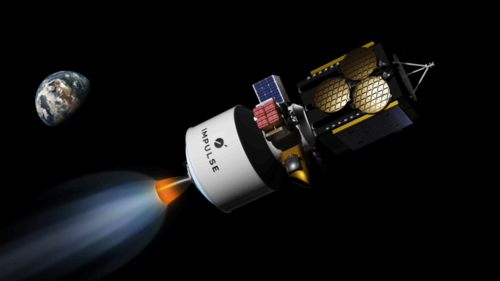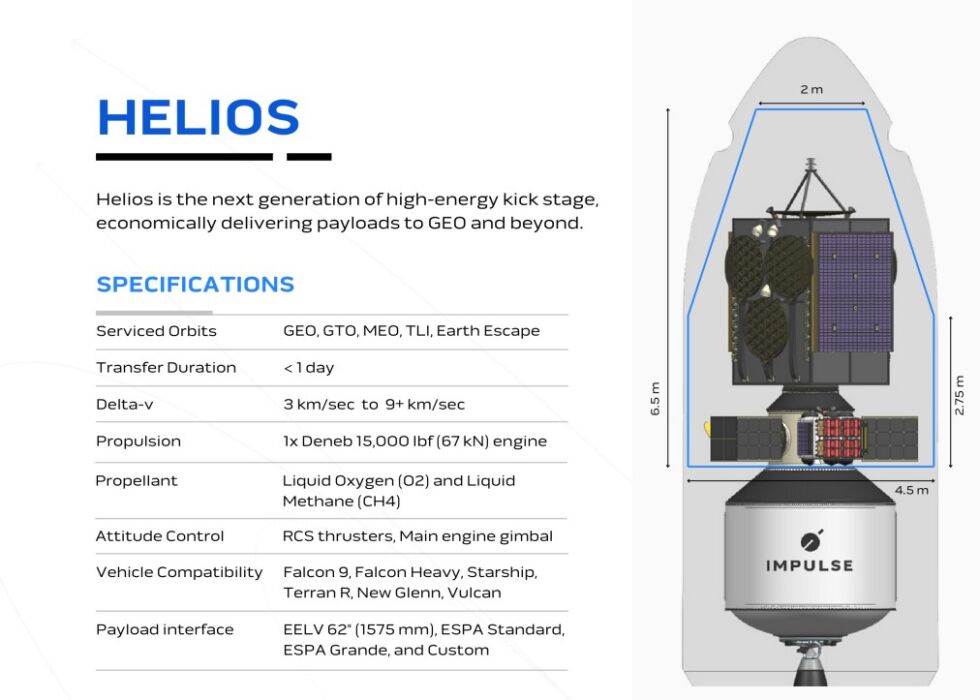
Impulse Space
In recent years there have been a number of modest ‘tugs’ brought online to ferry small satellites to designated orbits. These miniature spacecraft provide so-called last-mile service and are particularly useful for satellites that launch as a part of rideshare missions and seek to reach a different altitude or inclination than that of the primary payload.
However these space logistics vehicles, offered by a variety of companies, such as D-Orbit, Momentus, Launcher, and several others, generally are designed for satellites with a mass of a few dozen to a few hundred kilograms.
What has been lacking so far is a larger in-space tug that can haul bigger satellites to more distant orbits. That’s the market that a new spacecraft built by Impulse Space, Helios, intends to serve.
To GEO in a day
With a diameter of just under 5 meters, Helios is sized to fit within a Falcon 9 fairing. According to Impulse Space founder and chief executive Tom Mueller, the basic idea is to allow the low-cost Falcon 9 rocket to launch large satellites directly to geostationary space.
“We’re basically adding a third stage to a medium launch vehicle,” he said. “It’s basically doing most of what a Falcon Heavy will do for much less money, and without throwing away a core.”
Mueller was a founding employee at SpaceX and the lead designer of the company’s Merlin engines that power its Falcon rockets. However, he said the Helios vehicle is designed to fly on any medium- or heavy-lift vehicle to boost its capability for a single satellite. For example, Helios is intended to propel up to 4 tons launched on a Falcon 9, and 5 tons on Relativity’s Terran R vehicle, directly into geostationary orbit.

Impulse Space
At present, for medium and large satellites, there are two ways to reach geostationary orbit directly. A customer can buy a launch on a Falcon Heavy or United Launch Alliance’s Vulcan rocket, which is fairly expensive, likely about double the cost of a single Falcon 9 launch. Or a satellite can launch on a medium-lift vehicle and go into a transfer orbit to geostationary space, necessitating a robust on-board propulsion system, up to $5 million in Xenon or other propellant, and six to eight months of lost revenue during the ride up.
“We’re offering to get there in a day, for a much lower cost than either of those,” Mueller said.
From Mira to Helios
Helios will be powered by one of the most robust in-space engines ever built, named Deneb. It is on par with the venerable RL-10 engine manufactured by Aerojet and will have a thrust of 15,000 pounds (67 kN), and be powered by liquid oxygen and liquid methane. The fuel choice is partly a nod to the reusable future of spaceflight that Impulse Space hopes to tap into. “SpaceX needs 1,000 [metric] tons to refuel Starship,” he said. “Just give us a sip. We’ll take our 14 tons, and we’ll be glad to pay for it. And we can continue to reuse these.”
Mueller said the company is building components of the Deneb engine now and should start testing in March. The company plans to begin testing a full build of the engine later this summer. The Helios spacecraft is intended to debut in 2026. It may not be alone in serving larger satellites. Blue Origin has announced plans for a “Blue Ring” spacecraft platform capable of hosting payloads up to 3 tons.
This all sounds pretty ambitious, but Impulse has already moved quickly since its founding in 2020, flying its first spacecraft last year. Designated Mira, the spacecraft has performed well on its debut mission LEO Express 1. After it deployed a few small satellites, Impulse has been putting Mira’s propulsion system through its paces. This vehicle will compete with other spacecraft to provide last-mile services for small satellites, and it has also given Impulse confidence in its plans for Helios.
Now operating with about 90 employees, Mueller intends for Impulse to build upon the success of SpaceX. That launch company is well on its way to solving the problem of low-cost access to space with the Falcon 9 rocket now, and Starship in the near future. Impulse Space seeks to join other commercial space companies leveraging that capability by building spacecraft that can do new, interesting, and sustainable things in space.

